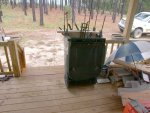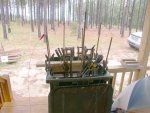Marty Walsh
Member
- Messages
- 1,396
- Location
- Southern Georgia
Here I go again...another tool gloat...
And this one...unlike Denise's lathe...is all MINE!
I've been wanting a JLT clamp rack since I first heard of them (thanks to tod!)
Well, eBay let my wish become reality today....actually at midnight last night. I was hoping to find a 6' rack complete with clamps for a good discount. That wasn't meant to be. Instead, I found a TWELVE foot rack complete with clamps...for less than ONE THIRD the cost of new.
It's HUGE...and HEAVY! Here it is hanging out the back of my truck after the trip home:
 ..........
..........
With the clamps and rack legs out of the truck, it was time to get that monster out and on it's way into the shop. TIme for the shop crane:
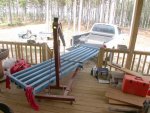
Denise helped me guide the rack into position...then helped getting things bolted back together once it was in position. (Thanks Denise!!! ):
):
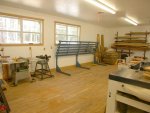 ........
........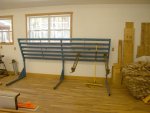
So, there's the 12' rack. Here are the 27 actual clamps that came with the rack:
 .........
.........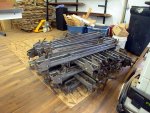
This is a used rack and clamp system. That means there's gonna be a massive cleanup effort to get the four years of glue off the clamps. It's not visible in the pictures...but trust me, they're a MESS! And much to my chagrin, the previous owner liked to use plastic resin glue...so getting it off isn't too easy!
Here's a picture of a few clamps that I did an initial glue-scrape-off to get into the rack:
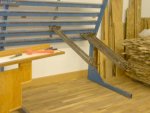
I think...once we get them cleaned up...they'll serve us well!
Speaking of cleaning off old glue...I've tried lacquer thinner, mineral spirits, and Bix paint stripper. None of them made even a minor dent in the glue. The few clamps I cleaned up enough to sort-of use, I scraped with a 5-in-one and a chisel. We tried a torch...to melt the glue...and are seriously considering lighting a fire and chucking the clamps in to melt the glue. But that seems awful drastic. There's GOT to be an easier way.
Any clean-up suggestions?
- Marty -
And this one...unlike Denise's lathe...is all MINE!
I've been wanting a JLT clamp rack since I first heard of them (thanks to tod!)
Well, eBay let my wish become reality today....actually at midnight last night. I was hoping to find a 6' rack complete with clamps for a good discount. That wasn't meant to be. Instead, I found a TWELVE foot rack complete with clamps...for less than ONE THIRD the cost of new.
It's HUGE...and HEAVY! Here it is hanging out the back of my truck after the trip home:
 ..........
..........
With the clamps and rack legs out of the truck, it was time to get that monster out and on it's way into the shop. TIme for the shop crane:

Denise helped me guide the rack into position...then helped getting things bolted back together once it was in position. (Thanks Denise!!!
 ):
): ........
........
So, there's the 12' rack. Here are the 27 actual clamps that came with the rack:
 .........
.........
This is a used rack and clamp system. That means there's gonna be a massive cleanup effort to get the four years of glue off the clamps. It's not visible in the pictures...but trust me, they're a MESS! And much to my chagrin, the previous owner liked to use plastic resin glue...so getting it off isn't too easy!

Here's a picture of a few clamps that I did an initial glue-scrape-off to get into the rack:

I think...once we get them cleaned up...they'll serve us well!

Speaking of cleaning off old glue...I've tried lacquer thinner, mineral spirits, and Bix paint stripper. None of them made even a minor dent in the glue. The few clamps I cleaned up enough to sort-of use, I scraped with a 5-in-one and a chisel. We tried a torch...to melt the glue...and are seriously considering lighting a fire and chucking the clamps in to melt the glue. But that seems awful drastic. There's GOT to be an easier way.
Any clean-up suggestions?
- Marty -



 . Great score.
. Great score.




